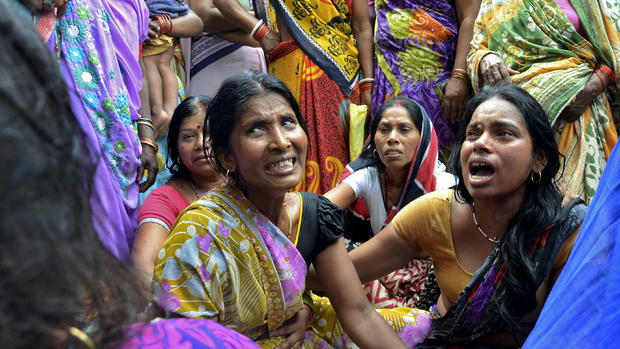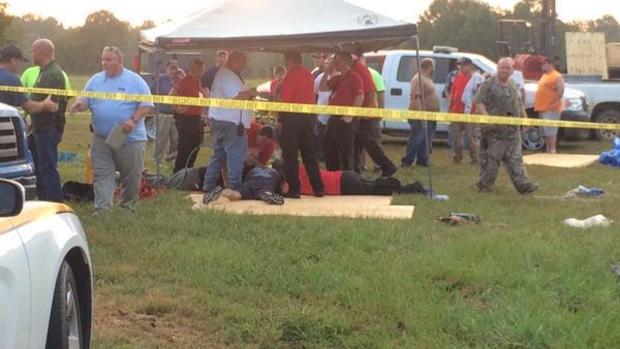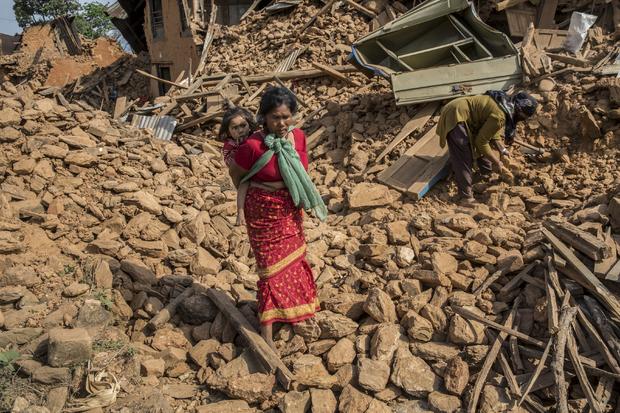Incredible survival story from quake-ravaged Nepal
KATHMANDU, Nepal -- A long-absent noise - cheers - rang out in Nepal's capital Thursday as rescuers pulled a teenager alive from the earthquake rubble he had been trapped in for five days. A woman was rescued hours later. The joy interrupted a dreary and still fearful day in which thousands worried about aftershocks lined up to board free buses to their rural hometowns.
Pemba Tamang was carried out on a stretcher, his face was covered in dust. Medics had put an IV drip into his arm and a blue brace had been placed around his neck. He appeared stunned, and his eyes blinked in the sunlight.
Nepalese rescuers, with support from an American disaster response team, had been working for hours to free Tamang, 15.
Editor's Note: A family member earlier told CBS News that Tamang went by the name Pemba Lama and gave his age as 17. Tamang himself has since confirmed his name and age to CBS News at a field hospital in Kathmandu.
On Thursday evening, police in Kathmandu said a woman in her 20s, Krishna Devi Khadka, was rescued from earthquake rubble in another location. She had been trapped in an area near Kathmandu's main bus terminal where there are lots of hotels, said a police officer who spoke on condition of anonymity because he wasn't authorized to speak to media.
CBS News correspondent Seth Doane and his team were there when Tamang was pulled out. Doane said it was controlled chaos as rescuers from the Los Angeles County Urban Search and Rescue, Fairfax County, Virginia, Nepalese teams and crews from around the world quickly reacted upon hearing a voice from within the rubble heap.
L.B. Basnet, the police officer who crawled into a gap in the rubble to reach Tamang, said he was surprisingly responsive.
"He thanked me when I first approached him," said Basnet. "He told me his name, his address, and I gave him some water. I assured him we were near to him."
Rescuers eventually used jacks to lift the concrete slabs that had wedged him in, said Basnet.
An American disaster response team had been helping the Nepalese.
"He's not too far down, but the floors have collapsed and he'd pancaked between them," said Andrew Olvera, an urban search and rescue team member from the USAID Disaster Assistance Repsonse Team.
Twisted ropes of steel reinforcing rods were all that stopped huge concrete slabs from falling onto the scene. Two concrete floors hung down in front of the building like curtains.
"The whole operation is dangerous," Olvera said. "But it's risk versus gain. To save a human life, we'll risk almost anything."
Asked how Tamang had lasted for so many days, Basnet replied: "He survived by good faith." He later told CBS News he actually survived by eating ghee, a clarified form of butter used in many dishes in the region.
The rescue was a rare bit of good news in a city that has known little but despair since the earthquake hit Saturday, leaving more than 5,500 people dead across this poverty-wracked Himalayan nation.
With aid slow to reach hard-hit villages near the epicenter, and the sheer overwhelming need for food, water and shelter in Kathmandu, anger has begun to mount. Police and soldiers in riot gear were seen Wednesday in Kathmandu for the first time since the quake struck.
Tens of thousands of people desperate to leave the capital city in hope of reaching family and safer ground in other parts of the country lined up for government-provided bus tickets. But there were too few to go around, which, along with the shortage of supplies and chaotic distribution, sparked angry protests Wednesday.
"I have to get home. It has already been so many days," said Shanti Kumari, with her 7-year-old daughter, who was desperate to check on relatives in her home village in eastern Nepal. "I want to get at least a night of peace."
Five days after the quake, tent cities in Kathmandu had thinned out, as overnight rainfall persuaded many people to return to their homes, even if they were damaged by the quake. The streets of the capital were slick with rain Thursday morning, the potholes were filled with water.
Still, life in the capital was slowly returning to the way it had been before the quake. Small snack shops were open. At a leather goods shop, a merchant brushed dust from a jacket on display. A man laid out carpets and rugs beneath an awning at a handicrafts store. Foreigners stood in line at a cellphone store.
"It's getting back to normal, but we're still feeling aftershocks. It still doesn't feel safe," said Prabhu Dutta, a 27-year-old banker from Kathmandu. He said he felt four aftershocks in the morning, including one that rattled the sliding glass doors of the bookshelf in his bedroom --"My morning wakeup notice," he said.
Dutta has been sleeping in his home, which has some cracks in the wall, for two nights, but the dozens of small aftershocks that he has felt since Saturday's huge quake make him uneasy. "I am worried about whether they will continue for a long time or whether it will calm down."
He said some people are returning to work, including at his bank, "but we can't concentrate. We roam around the office. We only have one topic of conversation: the earthquake."
Many people in Kathmandu are going to the country fearing that a big aftershock is coming, he said. "They are afraid; everyone is afraid because the earthquakes haven't stopped fully."
On Wednesday, helicopters finally brought food, temporary shelter and other aid to villages northwest of Kathmandu in the mountainous Gorkha District near the epicenter. Entire clusters of homes there were reduced to piles of stone and splintered wood. Women greeted the delivery with repeated cries of "We are hungry!"
While the death toll in the village of Gumda was low -- only five people were killed and 20 were injured among 1,300 residents -- most had lost their homes and desperately needed temporary shelter, along with the 90-pound sacks of rice that were delivered Wednesday.
Meanwhile, at least 210 foreign trekkers and residents stranded in the Langtang area north of Kathmandu had been rescued, government administrator Gautam Rimal said. The area, which borders Tibet, is popular with tourists.
Police said the official death toll in Nepal had reached 5,489. That figure did not include the 19 people killed at Mount Everest -- five foreign climbers and 14 Nepalese Sherpa guides -- when the quake caused an avalanche at base camp.
Dutta, the banker, said that while many of Kathmandu's cement and concrete buildings survived with only minor damage, many of the older buildings, ones made of tile or wood or bricks, have been leveled.
"Things have to return to normal, but it will take time," he said. "No one is ready to do the work needed to recover because of the closeness of the deaths. There is still shock."



